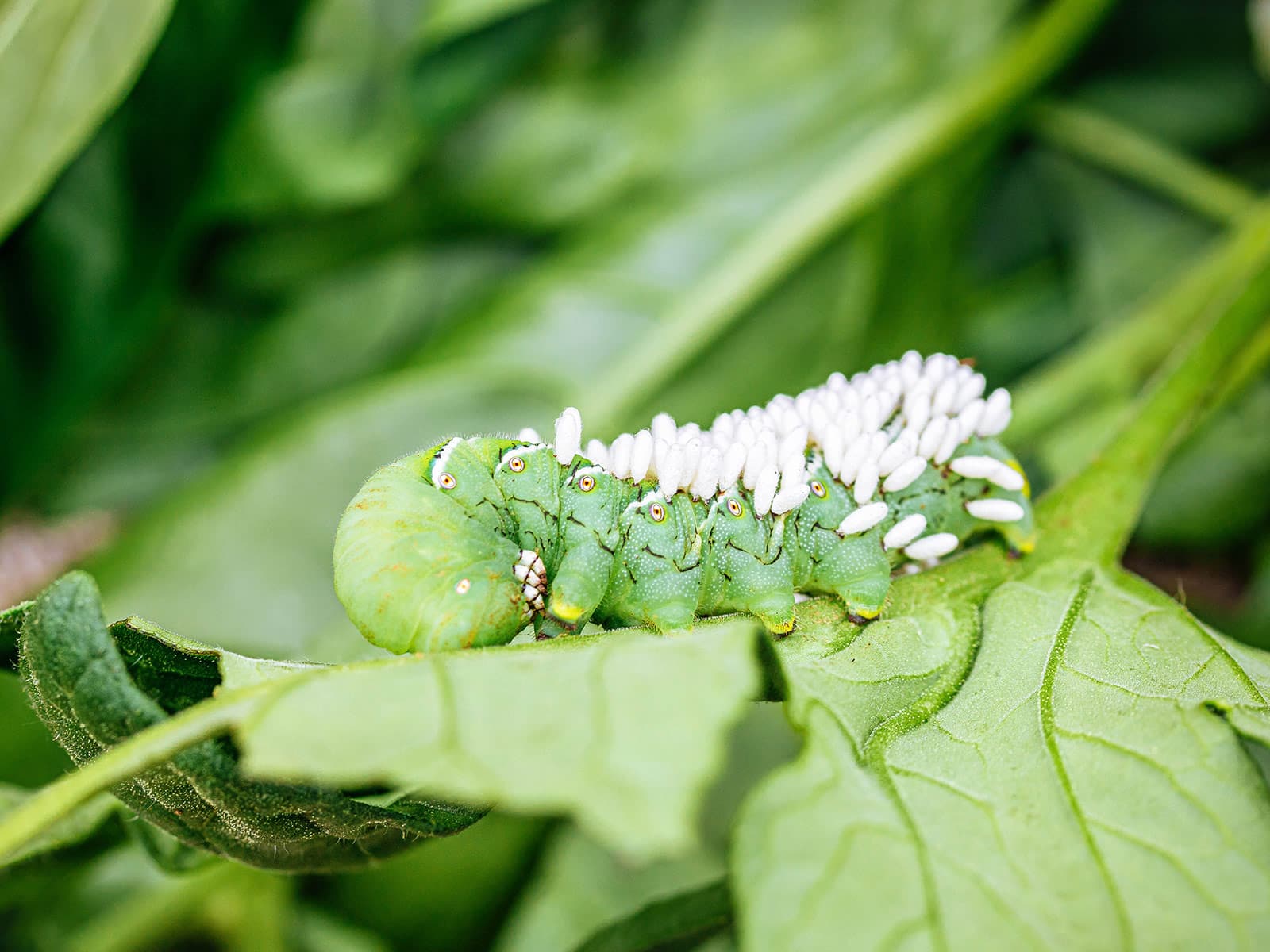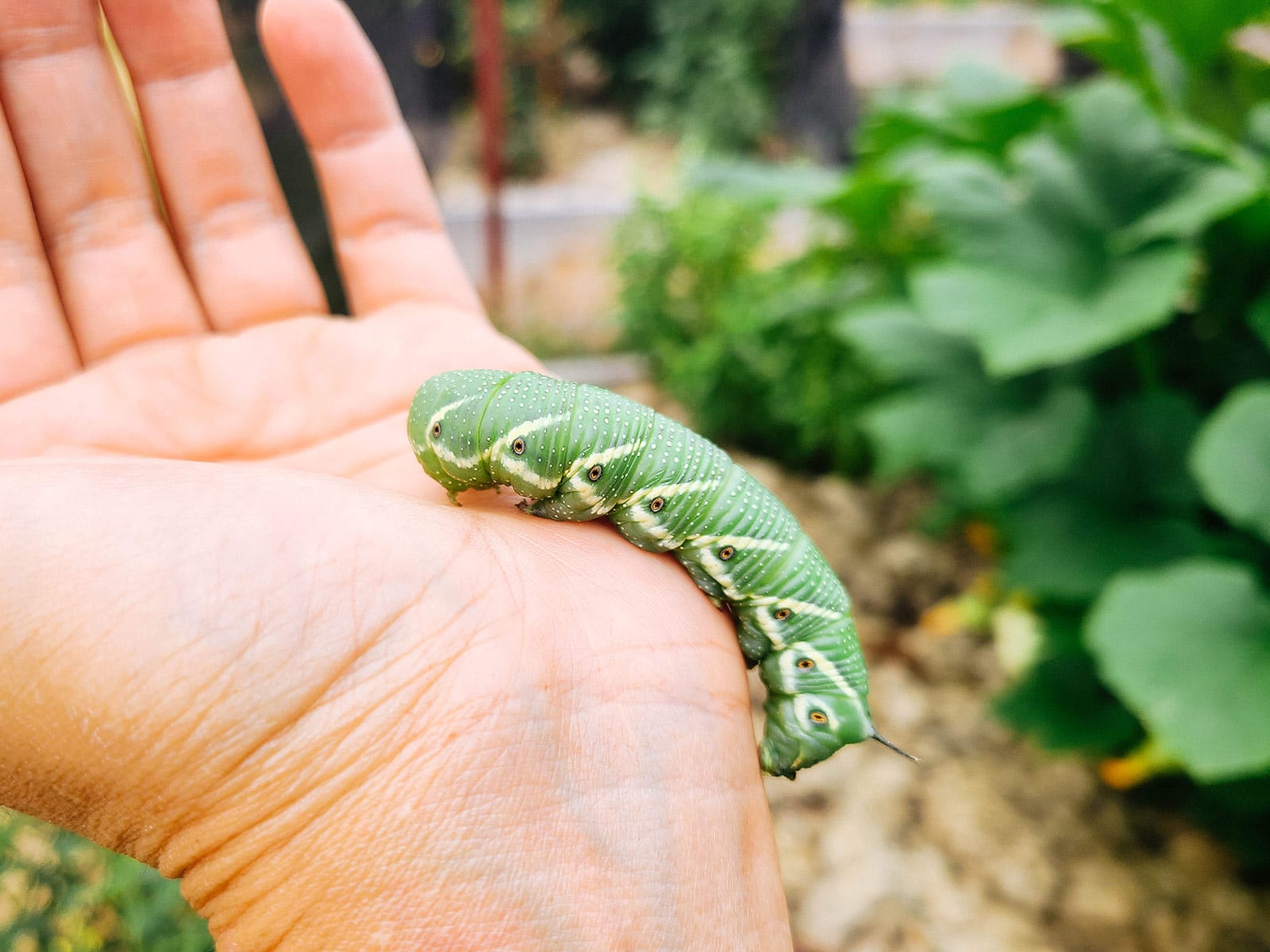If you’ve got a healthy crop of tomatoes growing, at some point you’re bound to spot these big, juicy green caterpillars happily munching on the leaves. They can grow to astonishing sizes—up to 4 or 5 inches long!—and get their name from the distinctive horn on their rear end that looks like a little spike (which, thankfully, isn’t capable of stinging).
There are actually two types of hornworms and many people (as well as other guides) mistake one for the other.
Tomato hornworms are the larval stage of the five-spotted hawkmoth (Manduca quinquemaculata). These caterpillars have a dark blue or black horn, and green margins along a series of white Vs (chevrons).

Tobacco hornworms are the larvae of the Carolina sphinx moth (Manduca sexta). These caterpillars have a red horn and black margins along white diagonal stripes.

Hawkmoths and sphinx moths are generally known as hummingbird moths (and occasionally mistaken for hummingbirds at quick glance) since they flit from flower to flower, feeding on nectar and pollen.
Learn more: These dramatic colorful moths rival the beauty of butterflies
Whichever hornworm you come across, it’s no friend if you’re a gardener. Both feed on tomatoes and other members of the nightshade family (including tomatillos, peppers, eggplants, and potatoes) and if left unchecked, full-grown hornworms can decimate an entire plant within days!

Their most voracious eating happens during their last week as caterpillars. Once they’ve finished off the foliage, they sometimes move on to the fruit.

Hornworms are both easy to see (once you know what to look for) and easy to miss (as they tend to lurk on the undersides of leaves). If you suspect hornworms are snacking on your plants, here are four easy ways to get rid of them—for good—without resorting to chemical controls.
Disclosure: If you shop from my article or make a purchase through one of my links, I may receive commissions on some of the products I recommend.
What hornworm damage looks like
First, are you sure you have hornworms? The first clue may be their excrement (also known as frass). Hornworm droppings are dark green and barrel-shaped, and sometimes look like tiny grenades scattered on the leaves or at the base of your plants. The larger the droppings, the larger the caterpillar!

Secondly, look at your leaves. If you notice missing tomato leaves or chewed-off stems, especially on the tips of branches, trace them back and you may also find a trail of frass and—ultimately—a hornworm camouflaged along a stem or the vein of a leaf.

The best and easiest way to control these caterpillars?
Hand-pick hornworms as you see them
Because of their size, hornworms are easy to pick off and discard. They’re an excellent source of protein for chickens, if you raise your own flock at home, but you can also simply drop the hornworms into soapy water to destroy them. (I keep empty coffee cans and yogurt containers around for this reason.)
Hornworms tend to come out at dusk to feed, so you can turn it into a fun evening adventure with this $12 flashlight.
Go out at night with your black-light flashlight and shine it slowly over your tomato plants. Hornworms will glow like little white reflector strips among the leaves, making them super easy to spot.

Remove them one by one and either smush them, drop them into a can of soapy water, or collect them in a jar to feed your chickens. (Don’t forget to check your other nightshade plants too.)
Remember that eggs may continue hatch for a few days after you’ve picked off every caterpillar, so repeat the “hunt” until you’re certain every hornworm is gone. In most climates, there’s only one generation per year, but gardeners in warm climates may see a second generation in late summer.
Turn your garden into a haven for beneficial insects
Soft-bodied hornworms have many natural enemies, including ladybugs and green lacewings (whose larvae feed on the eggs and young caterpillars), braconid wasps (which parasitize caterpillars by laying eggs inside them), and paper wasps and yellowjackets (which collect newly hatched hornworms to feed their own larvae).
Read more: How to identify common wasps in your yard
You can attract these beneficial insects to your garden by planting a large variety of flowering plants, such as those in the Apiaceae family (parsley, cilantro, fennel, dill, Queen Anne’s lace), Asteraceae family (chamomile, fleabane, goldenrod, sunflowers), and other umbellifers and simple, single-layered flowers, including yarrow, sweet alyssum, cosmos, and coreopsis.

If you see a paper wasp or yellowjacket nest near your garden, don’t be so quick to remove it. As long as the nest is a safe distance from where you normally gather and hasn’t grown too large, you can leave it to be a critical part of your ecosystem.
Leave parasitized hornworms alone
So now you’ve got entire armies of lacewings, braconid wasps, and other predatory insects feasting in your garden—hooray!
If you see a hornworm on your tomato plant with tiny white “rice grains” attached to its body, leave it alone. It’s been parasitized by braconid wasps, and those white things are their cocoons.

More wasps will hatch from those cocoons and continue the cycle of attacking other hornworms as they feed and grow.
Grow flowering tobacco as a trap crop
Flowering tobacco (Nicotiana spp.) is a highly fragrant flower that’s part of the nightshade family. A few species are quite attractive and make a beautiful addition to a flower garden.
One of my favorites is Nicotiana sylvestris with its large leaves and clusters of white flowers that look like little bursts of fireworks. Also called white shooting stars, the plant is a short-lived tender perennial that’s hardy to zone 10, but is so fast-growing that most people grow it as an annual.

Another favorite is Nicotiana alata ‘Lime Green’, which has long-lasting, trumpet-shaped chartreuse blooms. I love how the star-like flowers look when layered with hummingbird mint and salvia (which also attracts tons of pollinators).
Where to buy
Flowering tobacco
You can plant a patch of flowering tobacco as a trap crop, far away from your tomatoes and other nightshades. What makes them effective as a trap crop is that their flowers open at night (or during the cooler parts of the day) and emit a wonderful fragrance, attracting nighttime pollinators like sphinx moths.
Related: Surprising reasons you actually want moths around in your garden
Sphinx moths will lay their eggs on Nicotiana plants, sparing your tomatoes from destruction. In midsummer after the first flush of flowers fades, cut back the plants by at least half their size. This haircut, called deadheading, will give you another round of sweet-smelling blooms.
Meanwhile, you might just find a few (or more) hornworms lingering in the leaves! You can choose to leave them and let the hornworms continue their life cycle into sphinx moths, or dispose of them if your plants aren’t able to sustain their damage.
















Thank you for the information. We always thought the horn was a stinger and we didn’t know we could feed them to our chickens. Also, we will plant Nicotina acoss the yard next year, what an excellent way to bring more beauty and pollinators.
Self rising flour will kill cutworms and caterpillars. They eat it and it expands in their gut , thus killing them.
To be honest, this sounds like an old wives’ tale. I haven’t found any evidence that flour or baking powder (the ingredients in self-rising flour) have any effect on caterpillars (or other bugs, for that matter).
Why would you try to attract beneficial insects to your yard – and then kill their food source? Also why would you plant tobacco for the hornworms and then cut them back so there are fewer leaves for the hornworms?? And finally – why would you destroy pollinators???
Sorry. You’ve lost me on this one. Going to have to unsubscribe.
It seems like you’re misunderstanding the purpose of this article. For the most part, hornworms are considered serious pests in vegetable gardens and while a few here and there usually aren’t a problem (especially if you have a thriving ecosystem in your yard with plenty of beneficial insects), an overpopulation (usually caused by lack of beneficial insects) can certainly destroy your food crops. But if you’re growing enough tomatoes and peppers to go around, then by all means, leave the hornworms alone.
Helpful! Hornworm damage is so distinctive that most gardeners lean to identify it after now (probably shocking) experience of the damage they inflict. The parent hawkmoths are stunning to observe. In Florida. they would be attracted to our picture window along with insects almost too small to see and tree frogs (with suction-cup feet) that learned to show up for the nightly feast. The hawkmoth is huge, way bigger the second largest moth visitors. (I can’t see how it can be confused with a humming bird. They must an order of magnitude larger on the west coast, or in Mexico, for that matter, where I saw them at a feeding migration. One day, these hanging woody vines sported closed flower buds, sort of clustered like grapes, and the next day all the flower buds had opened and hundreds, if not thousands, of humming birds had arrived, as if telegraphed to the time and place of the feast. I wonder if humming birds have a sensitive sense of smell.) Back to the monster caterpillars, last year my daughter arose to the typical hornworm ravages of her tomatoes. But there were no hornworms to be found! We both looked. We didn’t miss any: there was no further damage. I suspect that our efforts a encouraging biological controls had paid off and the brids got then. Several crows had been hanging around, and they eat almost any kind of food to satisfy their ravenous appetite. This year I noticed a robin pulling grass from one of Cassandra’s beds, and I knew that we were gettin a lot of help again this year. While the robins are omnivorous a cluch of thier chicks get only pure animal protein. With a nest near the gardens, the parents have a great place to forage for their babies. Now if we have birds that will eat slugs, woodchucks and deer. our gardening will be trouble free. We live in Montpelier, the Capital of Vermont, and for good reason, it is illegal to discharge a firearm within city limits.
BTW. Hornworms are especially a problem around tobacco growing areas, for obvious reasons. I’m wondering if it is the same around large scale tomato growing.